Evolution of the Ancient Skin Boats
Ever imagine what the evolutionary jump felt like between crossing a river bear-hugging a floating log and that first inaugural voyage in a dug out tree trunk? Imagine then the resourceful person who took it one step further - fashioning a "floating tree trunk" where there were no trees? Who developed the idea of making a frame that would function as that tree trunk? Was the idea to cover it in the skin of an animal or the bark of a tree a concurring mental event? Or did one precipitate the other? In any event the evolutionary stages that took us from clinging to flotsam in a river to constructing and commanding a floating vessel is truly a remarkable feat.
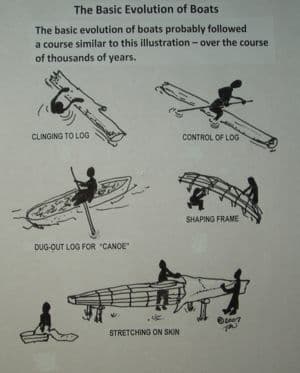
Mankind has developed four types of skin boats in the past umpteen thousand years s/he's been in a "tool /building" stage. In probable order of development are the: coracle, umiak, canoe, and kayak. Because of their frailty, there are few, if any early, ancient examples of skin boats. Frames and skins just don't last.
What do last, however, are cave drawings, etchings on pottery and in rare cases, accurate models of boats (toys perhaps?) of vessels presumably used during that artisan's life. The earliest example of a kayak is a small model tested to be about 5,000 years old. It was simply a spindle-shaped frame with what looks like two sealskins pulled tightly over it.
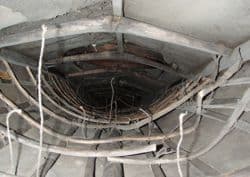
Inverted photo of interior of a two-person kayak from Kodiak, Alaska, looking along keelson to aft cockpit coaming. Ribs snap and skins harden and crack after scores of years of hanging from ceilings or stored in warehouse museums.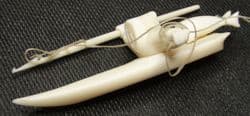
This ivory carving from Nome, Alaska, is typical of the types of models researchers had to rely on to determine how boats from antiquity were designed and constructed. This carving is only 3 inches long.
Here's a brief rundown of each of the four types of skin boats Man has created; vessels whose service to Mankind is still evident today in many parts of the world.
Coracle
The coracle is basically a bowl-shaped craft used primarily to cross small rivers or to negotiate ponds and smaller lakes. The frame can be constructed so as to provide a seat for the passenger. Propulsion is usually a long push pole, but also a paddle. Coracles come in a variety of sizes but most often four-six feet wide and usually about half their width in height.
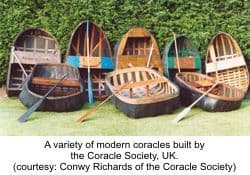
The frame is built in the form of a rounded box/bowl shape with cross ribs lashed together. The skins are wrapped around the outside and pulled tightly up to or over the circular gunwale/rim around the top. Cross pieces secured to the frame provided seat support. The coracle was widely used throughout northern Europe and the Mid East. I've also seen footage of them being used in Africa. Many third-world countries still use a coracle type of vessel today.
Umiak
This is the tradition skiff-shaped boat most often seen on shore in whaling villages. They come in all sizes, from 3-4-person size up to giant boats used for hunting whale. Historically the women of the village paddled the umiak when it was put into service except when it was being used for hunting - at which time only men operated the vessel.
In some Alaskan coastal communities even today, umiak style boats can be seen as the main freighter boats in a village - hauling materials, making deliveries, and such. Built with a tapered bow and stern, the umiak is an open-framed boat, covered in skin. It can be as big or as small as needed or as materials allow. Twenty-four-man umiaks, over twenty feet long and weighing a ton, were a common sight along the coastline of sub Arctic North America for hundreds of years.
During a brief visit to the remote Pribilof Islands in the North Pacific of Alaska I saw a well-worn umiak - about 18 feet long - braced against a warehouse down by a ramp leading into the ocean. Upon inquiry I was told that during rough seas, that particular umiak was used by a crew of five or six men to unload supply vessels that couldn't get past the breakwater. A week earlier they had gone out in rough seas to take delivery of a washing machine from a large fishing boat.
Kayaks
Models of these boats were popular items in pre-historic areas of the far northern hemisphere. Kayaks carved of fossilized whale, walrus ivory, stone and even some of wood are displayed in museums around the world. An easy form to carve, models do reflect the lifestyle of the representative groups by the detail cut into individual boats. Unlike their real-life counterparts, those made of bone, ivory or stone lasted much longer than did the wooden frames and skins so researchers base much of their pre-historic knowledge on such models.
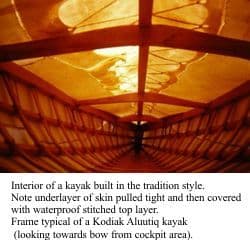
The uniqueness of the kayak is that there is no other craft out there that looks anything like it, nor was concurrently developed in any other part of the world. It could be argued that the skin or bark canoe and dugouts of the Pacific Northwest and others around the world follow a basic design concept. The kayak with its closed deck and cockpit configuration is quite unique.
Canoes
From birch bark to wood strip to a brilliant shine of aluminum and modern composites, the canoe is clearly respected as a North American frontier icon. I have always thought it incredibly ingenious of the Native Americans to develop the birch bark canoe. It's classic lines and the ingenuity of piecing the bark together and forming a waterproof seam has to be one of the greater natural technological feats of early mankind. Interestingly enough, the "canoes" of the inland waterways of Alaska are strikingly similar in appearance to the coastal kayaks - same hull design without a covered deck.
Like the umiak of the far north, the canoe's history is one of massive vessels maneuvered by large crews and carrying enormous weights. They were the semi trucks of early America. Eastern North America is criss-crossed with old Voyageur routes that weave down through Canada or out of the Great Lakes as intrepid, nomadic-like frontiersmen used rivers and lakes long before roads were even being formed as foot trails.
Modernization of freight and passenger hauling replaced the canoe in the twentieth century. Fortunately the love of the craft shifted its appeal from a workhorse to a play boat. Even more important is the fact that there are those who have preserved the art of skin boat building, both in kayaks and canoes, some even using the materials of yesteryear to maintain a pure sense of the boats everlasting appeal.
Tom Watson, an avid sea kayaker and freelance writer is also the author of "How to Think Like A Survivor" available on Amazon.com and most major bookstores.
Related Articles
Now, in this episode, we're going to the land of the Cree, where the great outdoors is more than a…
A recent article in Rapid Media’s on-line magazine listed seven reasons why now is a better time to be…
It’s somewhere along the north Pacific Rim, early spring. You need to build a boat in which you will…
The pack barrel's story goes back to the mid-1980s when a group of canoe guides from Ottawa, including…



